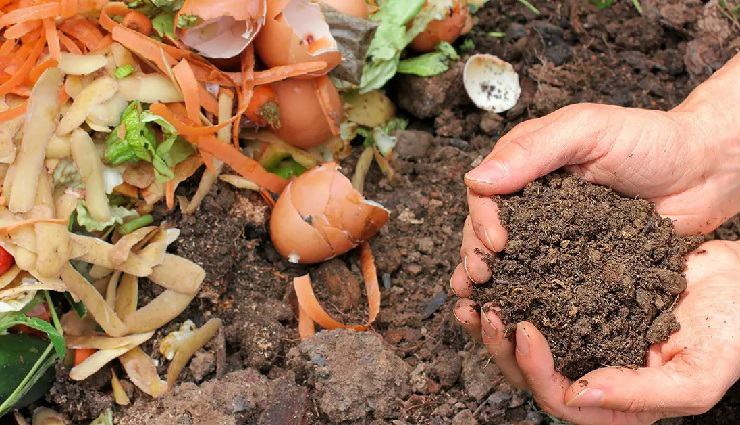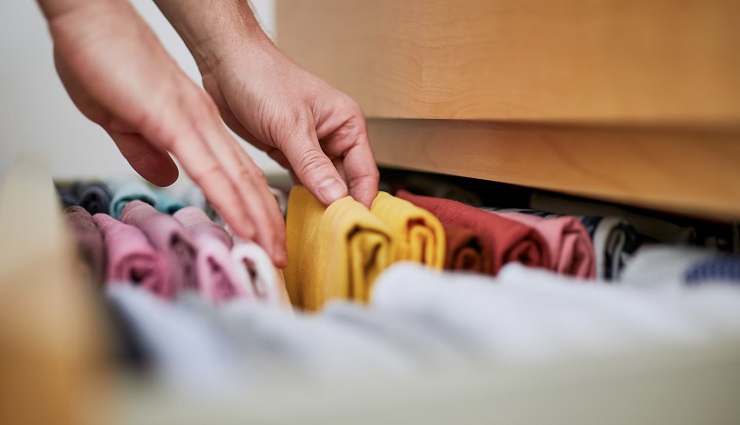In composting, organic materials such as leaves and food waste are turned into soil. This method is perfect for recycling garden and kitchen waste. Composting will likely be a satisfying hobby if you enjoy gardening and care about protecting the environment. Making compost is very easy, even in small spaces. In the following, we will learn about compost, its benefits, and how to produce it at home.
What is compost?
Compost is a material similar to soil and rich in nutrients that can improve soil quality and increase plant growth. Compost soil is a material rich in nutrients, which is also called “black gold.” Compost can be used for gardening and agriculture. Producing compost in nature is time-consuming, but we can increase its speed by creating suitable conditions for faster decomposition of materials.
Compost is not just rotted plant material; its production goes beyond the physical breakdown of materials into microscopic particles. This process includes the chemical and biological transformation of materials. Most of this transformation is done by microorganisms. Of course, larger organisms such as earthworms can also play a role in its various stages.
Insects eat and excrete organic matter. Microorganisms also feed on the materials added to the compost pile. Molecules undergo many chemical changes as they pass through the system of many organisms. The result is rich, dark, crunchy soil with more beneficial microbes than regular soil.
Benefits of using compost
- improving soil structure and health by adding organic matter;
- help to maintain soil moisture and nutrients;
- Absorbing beneficial organisms in the soil and reducing the need for pesticides and chemical fertilizers;
- Reducing the risk of soil erosion by collapsing compacted soils;
- sequestering carbon in the ground;
- Preventing waste from entering landfills and reducing the emission of solid greenhouse gases such as methane. (About 8% of greenhouse gases are produced from food waste.)
Choosing the suitable materials for compost production
Various organic materials, such as food waste, grass clippings, and human hair, can be composted. The materials you can use for composting are:
- Peels and scraps of fruits and vegetables;
- rotten fruits and vegetables;
- leaves and branches separated from houseplants ;
- coffee grounds and paper filters ;
- tea grounds and tea bags;
- Eggshell;
- Nuts (other than walnuts );
- Newspaper, non-glossy or colored paper, straw paper bags, and envelopes (not colored), unwaxed paperboard, adhesive tape, or liquid adhesive;
- unused napkins, napkins or paper towels, and toilet paper;
- cotton and wool fabrics;
- hair and fur;
- cut grass;
- leaves and flowers;
- straw and hay;
- sawdust;
- unpolished or unpainted wood chips;
- Stems and branches of plants.
Inappropriate materials
Some waste attracts insects and rodents, and some may contain harmful toxins. Some unsuitable materials for composting are:
- Bones, red meat, fish, and poultry: produce odors, attract pests, and may contain pathogens.
- Dairy products: produce odors and attract pests.
- Walnut: causes a compound that is toxic to plants.
- Coal ash or charcoal: Contains compounds that can harm plants.
- Large pieces of wood: It takes time to break them down.
- Grease, cooking, and motor oil: produce odors and attract pests such as rodents and flies.
- Foliage is impregnated with chemical pesticides and destroys the microorganisms necessary for composting.
- Coffee pad: usually contains plastic.
- Cooked foods: attract pests and increase the growth of harmful bacteria. (There is nothing wrong with small amounts.)
- Diseased or pest-infested plants: May transmit diseases or pests to other plants.
- Pet waste, such as feces or litter: may contain parasites, bacteria, microbes, pathogens, and viruses harmful to humans.
- Invasive weeds and seed-bearing weeds.
Some products have “compostable” written on them, such as “compostable bags.” These products are only composted in industrial facilities and are unsuitable for home composting.
Making compost at home
There are several ways to do this, including:
- You are composting in your backyard with a pile or bin you can make or buy yourself.
- Production of vermicompost (composting with worms) inside the bucket. Vermicompost production can also be done indoors.
Making compost in the backyard

For this, you need a balanced amount of the following ingredients:
- Carbon-rich (brown) materials include dry leaves, plant stems, twigs, and paper. Carbon-rich materials provide the necessary food for microorganisms.
- Nitrogen-rich (green) materials include fresh organic materials such as new leaves and food waste. These materials heat the mass to provide ideal conditions for material decomposition.
- Water (moisture).
- Air (oxygen).
In the following, we have explained the steps of composting in the yard.
1. Choose the right place
Choose an outdoor location that has good drainage, shade, and cover. A dry and shady place is the best place to compost. You should choose a site that is easily accessible and away from pets or wild animals. Please do not place the compost pile next to the wall, as it may stain it. Your bank should be at least 91 cm wide and high to retain heat.
You can use a trash can or an old wooden box or make a place to pile your trash with materials like wire, wood, and cinder blocks. A home composting bin is also a good option. A compost bin is designed to turn and mix materials more efficiently.
Before adding the green and brown ingredients to the mixture, break them into smaller pieces. This causes faster decomposition of materials.
2. Adding compostable materials
After choosing a suitable place for the pile, you must pour compostable material into it. Pour the green and brown ingredients alternately on top of each other. It is not necessary to layer the materials. Still, it makes you observe the correct ratio of green and brown materials so that the materials are decomposed faster. For better aeration and drainage, start with a 10 to 15-cm layer of bulky brown material such as branches and wood chips. This layer absorbs excess liquid, raises the mass, and allows air circulation at the bottom. Then add the green and brown ingredients alternately and layer by layer. If needed, add a small amount of water to moisten the ingredients.
Adhering to the proper proportions of the constituents in the compost mass gives the microorganisms the carbon, nitrogen, oxygen, and moisture they need to decompose the materials. The volume of brown material should be at least 2 to 3 times that of green fabric. Food waste should always be covered with a 10-20 cm layer of dry leaves or other brown material. Add enough brown stuff to ensure air circulation, and turn the stuff upside down now and then.
Green materials are usually wet and brown materials are dry. Place the dry brown ingredients below and the moist green ingredients on top of them. Brown materials cause water and air to flow. You can put a bit of brown fabric on the last layer to keep flies away and prevent unpleasant odor.
3. Regular turning of the compost mass
The next step is to turn the material for proper composting regularly. Occasional mixing of the mass accelerates its decomposition and aeration process. You can use a shovel or rake to twist and turn the material upside down to distribute air and moisture evenly. The time interval of stirring the compost depends on many things, such as the pile size, humidity, and the amount of brown and green material present. Usually, you have to stir the ingredients every 4 to 7 days. The closer the compost gets to the final stages, the less it should be turned over.
As the material in the mass begins to decompose, its temperature increases (especially in the center). In case of proper storage, the temperature of the compost mass reaches 54 to 71 degrees Celsius. High temperatures are effective in reducing pathogens and weed seeds.
Check the compost heap’s humidity, odor, and temperature and take necessary measures.
- If the pile is too dry, activity slows down or stops. Pour water into the mass and turn it upside down.
- If the mass smells terrible, it may be too moist or needs more air circulation. Add more brown or dry ingredients to the group and turn it upside down.
- If the mass does not heat up, add more green ingredients and stir the group.
If the weather is hot, two months are enough to decompose the material, but this process takes six months in cold weather. If you want all components of the compost mass to deteriorate, you probably need one year. If you have observed the correct ratio of green and brown ingredients, you should stir the group less.
4. Collecting produced compost
If the compost pile does not heat up after mixing and there is no visible waste, you must wait at least another four weeks to complete the process. You can move the oldest material at the bottom of the pile to a separate location or stop adding material. Finally, the volume of the mass becomes about one-third of the original size. Compost is ready for consumption when it is dark brown and crunchy and has a strong smell, like the smell of soil.
Sift or screen the finished compost to remove undecomposed material (twigs, fruit cores, and eggshells). You can add the undecomposed material to another compost pile.
Prevent the entry of rodents and pests
To prevent pests or rodents from entering the compost pile:
- If using a bucket, use a suitable lid. There should not be any holes or gaps larger than 6 mm in the bucket.
- Maintain the proper ratio of materials in a pile, i.e., 2-3 parts carbon-rich (brown) material to one part nitrogen-rich (green) material.
- Be sure to cover the food waste in the pile and bury it under other materials.
- Do not add meat, dairy, or fatty foods to the mass.
Vermicomposting production

One of the types of compost is vermicompost, the production of which requires little space and can be done inside or outside the house. This method requires a container or bucket, bedding material, worms, and food scraps. In the following, we have described the production steps of vermicompost.
1. Making a bucket of worms
You can use wooden or plastic buckets. The bin should have a tight lid and be dark in color to prevent light from entering. If you are using a plastic bucket, make drainage holes around the sides of the top of the bucket near the air holes and in the bottom of the bucket. Place the perforated bucket inside another bucket to catch the liquid from the first bucket.
2. Choose the right place
You can keep the worm bin indoors (under the sink, in a closet, or the basement) or outdoors in the shade. If you put the bucket outside, insulate it with blankets, blankets, or other materials to keep it warm during the year’s colder months. It would be best if you kept the temperature of the bucket at 15 to 25 degrees Celsius. If there is at least 10 cm of substrate, worms can survive at 0 to 35 degrees Celsius.
3. Preparing the worm bucket
For the worm bin, you will need the following:
- Worms: Out of 9 thousand species of earthworms, only seven species are suitable for vermicomposting. One of the most common worms is called red wriggler or Eisenia fetida.
- Litter: Shred or tear newspaper, waste paper, cardboard, or dry leaves. Soak the substrate for 10 minutes. Then shake the ingredients to remove excess water, put them in the bucket, and separate them. Fill about half the bucket with wet substrate and pour a handful of soil.
- Food: You can use fruit and vegetable scraps, coffee grounds and paper filters, crushed eggshells, and tea bags to feed the worms. Do not use citrus fruits, aromatic foods such as onions and garlic, meat, dairy products, fatty foods, bones, and pet waste. Break the trash into small pieces for faster decomposition before adding it to the bin.
4. Pouring worms into the bucket
Pour the worms on the substrate. After the worms have settled in the bin, sprinkle some food scraps on top of the substrate. Cover food with 5 cm of substrate every time you pour it. It is essential to add the correct proportion of materials to the bin and protect them. Worms eat about 25% of their weight per day. Worms multiply quickly, and you need to increase their food. Always make sure the worms have eaten the previous food before adding food.
5. Collecting vermicompost
After 3 to 6 months, you can harvest the vermicompost at the bottom of the bucket. You can consume the vermicompost immediately or save it for future use.
final word
Composting is a straightforward and helpful thing that, in addition to helping to enrich the soil, also reduces environmental pollution and your carbon footprint. Of course, composting requires patience, and you may encounter unexpected issues. Compost can be used in different ways; For example, you can combine it with potting soil, sprinkle it on the surface of the garden, or even earn money by producing and selling it.



